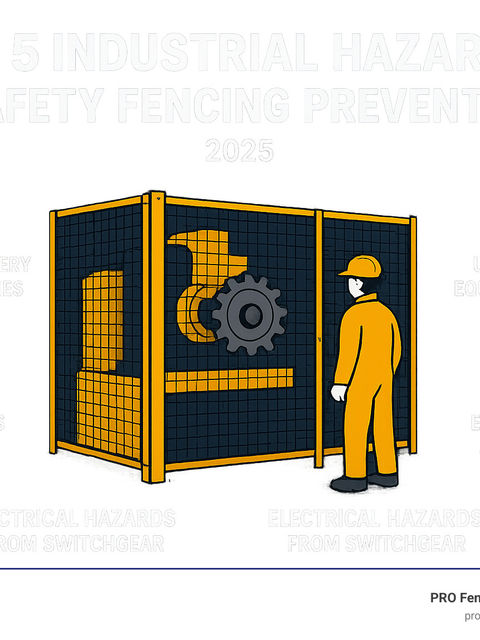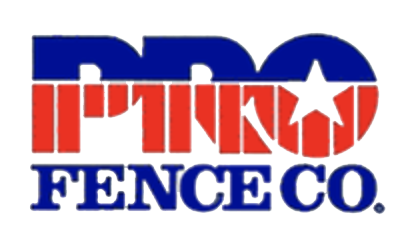Industrial Safety Fencing Explained Without the Jargon
- Pro Fence Wilmington

- Jul 13
- 6 min read
Why Industrial Safety Fencing is Critical for Your Facility
Industrial safety fencing is a specialized barrier system designed to protect workers and equipment from hazardous machinery in manufacturing and industrial environments. Unlike regular fencing, these systems must meet strict safety standards and integrate with safety controls to prevent accidents and maintain productivity.
Key purposes of industrial safety fencing:
Personnel Protection – Prevents contact with moving machinery, robots, and hazardous processes
Equipment Security – Shields valuable machinery from damage and unauthorized access
Regulatory Compliance – Meets OSHA, ANSI, and ISO safety standards
Productivity Improvement – Reduces downtime from accidents and equipment damage
Risk Management – Contains debris, sparks, and other workplace hazards
As one manufacturing safety expert noted: “In today’s manufacturing environment safety fencing plays an integral role in protecting employees from hazards posed by industrial machinery.” The research shows that proper machine guarding can significantly reduce workplace injuries while actually improving operational efficiency.
The most popular height for safety fencing is 2200mm (7.2ft), which covers a wide range of industrial applications and provides adequate protection for most machinery hazards. Modern systems are modular and can be easily customized to fit complex layouts while maintaining compliance with safety regulations.

What is Industrial Safety Fencing and Why is it Crucial?

Think of industrial safety fencing as the guardian of your manufacturing floor. More than a simple barrier, it creates a controlled zone around hazardous machines so your team can work without fear of accidental contact.
Workplace accidents carry a steep price — from lost production to fines and medical costs. Installing proper safety fencing is therefore both a compliance requirement and a smart financial move.
Modern systems use modular components that adapt to tight corners or sprawling layouts and can be re-configured when your process changes. If you need broader perimeter security, explore our Security Fencing options.
The Dual Role: Protecting People and Assets
Personnel safety: stops accidental reach-in or walk-in injuries.
Debris containment: keeps sparks, chips, and shavings inside the cell.
Asset protection: shields machinery from forklift bumps and blocks unauthorized access.
How Safety Fencing Boosts Productivity
A safeguarded workspace reduces accidents and the downtime that follows. Employees who feel protected stay focused, morale improves, and production keeps moving. In short, safety fencing does double duty: it guards people and helps your bottom line.
The Building Blocks: Key Components and Design Features

Modern safety fencing works like an industrial version of LEGO building blocks; mix standard parts to fit nearly any layout, then add or remove sections when your process changes. For a made-to-measure approach, see our Custom Fencing Solutions.
Fencing Panels: The First Line of Defense
Wire mesh – high visibility and airflow.
Sheet metal – full containment where flying debris is a concern.
Polycarbonate – clear, impact-resistant panels for visual inspection without exposure.
Mesh opening size matters: the smaller the opening, the closer the fence can sit to the hazard under ISO 13857.
Support Posts and Hardware
Heavy-gauge, powder-coated steel posts anchor the system. Factory-drilled base plates and bolt-together fittings speed installation and simplify future moves.
Access Doors and Gates
Hinged or sliding doors paired with safety interlocks stop machinery the instant a panel is opened, giving maintenance staff secure, code-compliant entry.
Navigating Safety Standards for Industrial Safety Fencing
Regulations exist to ensure guards really do prevent injury. Ignoring them risks far more than OSHA penalties; downtime, lawsuits, and higher insurance premiums quickly dwarf any fine.
OSHA Basics
OSHA 1910 Subpart O requires employers to isolate moving parts so workers cannot reach them. When a guard cannot be attached directly to the machine, industrial safety fencing provides the “secured elsewhere” solution.
Other Key Standards (ANSI, RIA, ISO)
ANSI: detailed design guidance that often informs OSHA citations.
RIA: robot-specific rules for safeguarding work cells.
ISO 13857: tables for fence height vs. reach distance (e.g., a 2200 mm fence must sit at least 400 mm from the hazard when using 20 mm mesh).
Using these references during design keeps you compliant wherever your line operates.
From Plan to Plant Floor: Choosing and Implementing Your System

Conducting a Risk Assessment
Walk the floor and list every point where someone could touch a hazard, where debris could escape, or where equipment needs secure access. Documenting this audit guides the fence layout and satisfies inspectors later.
Selecting Your System
Key questions:
What hazards are present (robot, press, conveyor, electrical)?
How harsh is the environment (humidity, chemicals, temperature)?
Will forklifts operate nearby? If yes, choose impact-rated posts.
Do you need future flexibility? Modular, tool-free panels make rearrangements painless.
Balancing Safety and Productivity
Durable, powder-coated steel may cost more up front but pays for itself through decades of use and minimal maintenance. Phased installation keeps production running while new fencing goes in. Our Industrial Fencing Services team can design a schedule that avoids major shutdowns.
Where You’ll Find Safety Fencing: Common Applications
Industrial safety fencing is everywhere in modern manufacturing, and once you know what to look for, you’ll spot it in virtually every industrial facility. These versatile systems adapt to countless environments, each with its own unique challenges and requirements.
Robotic work cells represent one of the most critical applications for safety fencing. As automation becomes more prevalent, these cells need robust protection that can contain debris while allowing operators to monitor the process. The fencing in these areas often integrates with sophisticated safety systems that can instantly halt robot operations when maintenance access is needed.
Automated welding areas present particularly demanding conditions for safety fencing. These environments generate intense heat, bright flashes, and flying sparks that require specialized protection. The fencing here doesn’t just protect people—it also shields nearby equipment and materials from damage.
Palletized conveyor systems create unique safety challenges because they combine moving machinery with heavy materials handling. Safety fencing in these areas prevents workers from accidentally entering dangerous zones while materials are being moved, and it helps contain any items that might fall from the conveyor.
Machine perimeter guarding is perhaps the most straightforward application, creating clear boundaries around individual pieces of equipment. Whether it’s a large press, a cutting machine, or packaging equipment, perimeter fencing ensures workers maintain safe distances while still allowing necessary access for operation and maintenance.
Tool cribs benefit from safety fencing in a different way—here the focus shifts to security and controlled access. The fencing protects valuable tools and equipment while maintaining the visibility needed for inventory management. Many facilities use specialized panels that provide excellent security without creating a fortress-like appearance.
Hazardous waste storage areas require fencing that can contain dangerous materials while preventing unauthorized access. These installations often feature specialized panels and improved security features to meet both safety and environmental regulations.
Electrical switchgear protection is another critical application where safety fencing literally saves lives. These installations must balance the need for absolute protection from electrical hazards with the requirement for maintenance access by qualified personnel.
Each of these applications demonstrates how industrial safety fencing adapts to specific needs while maintaining core safety principles. The beauty of modern modular systems is that they can be configured for any of these applications using proven, tested components rather than requiring completely custom solutions.
For more comprehensive information about industrial applications, explore our Industrial Fencing services and solutions.
Frequently Asked Questions about Industrial Fencing
How tall does a safety fence need to be?
The required height depends on a thorough risk assessment and compliance with standards like OSHA and ISO 13857. It must be tall enough to prevent personnel from reaching over, under, or through to the hazard. A common and versatile height is 2200mm (7.2ft), which is the most popular choice for safety fencing and covers a wide range of applications.
The specific height calculation considers the type of hazard, the mesh opening size, and the horizontal distance available. ISO 13857 provides detailed tables showing the relationship between these factors. For instance, a 2200mm tall fence requires at least 400mm horizontal clearance when used with standard mesh openings.
Can safety fencing be customized for my specific layout?
Absolutely. Modern industrial safety fencing is designed to be modular, with panels available in 14 different widths ranging from 250mm to 2000mm, and doors available in 10 different widths from 1000mm to 6000mm. Eight different fence heights are offered, from 1200mm to 4250mm, allowing for precise customization.
The modular design means panels, posts, and doors can be combined to fit complex layouts, accommodate obstructions, and be easily reconfigured or expanded as your facility’s needs change. Many systems feature quick-connect fittings that allow for tool-free assembly and reconfiguration.
What makes industrial safety fencing different from other types of fencing?
While other fences, like commercial fencing, provide general security, industrial safety fencing is purpose-built to meet strict machine guarding standards. It features specific mesh sizes calculated to prevent limb contact with hazards, impact resistance to withstand industrial environments, and integration with safety components like electronic interlocks.
Industrial safety fencing must comply with OSHA, ANSI, and ISO standards, which specify requirements for strength, durability, and safety performance. These systems are designed to actively protect workers from specific industrial hazards rather than simply providing perimeter security.
The materials used are also different—industrial safety fencing typically uses heavier gauge steel (like 14-gauge frames and 10-gauge mesh) and specialized coatings to withstand harsh industrial environments. The hardware is designed for frequent use and potential impacts from forklifts and other equipment.

Secure Your Facility with Expert Fencing Solutions
Proper industrial safety fencing lowers accidents, cuts downtime, and raises morale a triple win for any manufacturer in Wilmington or across Middlesex and Essex Counties.
The modular systems we install today will adapt to tomorrows production changes, protecting both your people and your investment.
Ready to move forward? Explore our full range of Security Fencing options or Request an Estimate to get personalized advice from the family-owned team at PRO Fence Co. Wilmington.




Comments